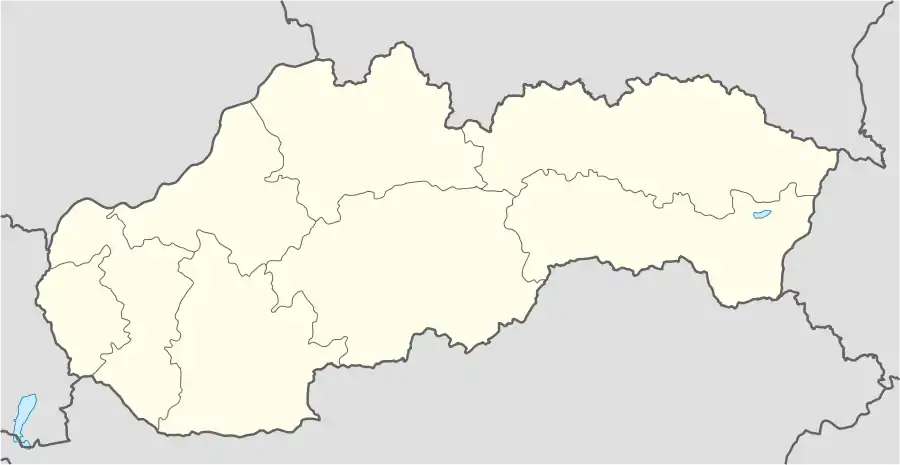Vráble | |
|---|---|
Town | |
 Church of the Virgin Mary | |
 Coat of arms | |
 Vráble Location of Vráble in Slovakia | |
| Coordinates: 48°14′27″N 18°18′31″E / 48.24083°N 18.30861°E | |
| Country | Slovakia |
| Region | Nitra |
| District | Nitra |
| First mentioned | 1265 |
| Government | |
| • Mayor | Viktor Németh |
| Area | |
| • Total | 38.31[1] km2 (14.79[1] sq mi) |
| Elevation | 144[2] m (472[2] ft) |
| Population (2021) | |
| • Total | 8,488[3] |
| Time zone | UTC+1 (CET) |
| • Summer (DST) | UTC+2 (CEST) |
| Postal code | 952 01[2] |
| Area code | +421 37[2] |
| Car plate | NR |
| Website | www.vrable.sk |
Vráble (Hungarian: Verebély) is a small town in the Nitra District, Nitra Region, western Slovakia.
Etymology
The name derives from vrábeľ - a Slovak dialect name of sparrow (vrabec).[4]
Geography
It is located in the Danubian Hills on the Žitava river, about 15 kilometres (9.3 miles) south-east-east from Nitra. The cadastral area of the town has an altitude from 140 to 240 metres (460 to 790 feet) ASL. There's a small dam called Vodná nádrž Vráble west of the town.
The town has three parts: Vráble proper, and the former villages of Dyčka and Horný Ohaj (both annexed 1975).
History
The oldest evidence of the settlement of Vráble comes from the Neolithic age (6000-2000 BC). The first written reference is from 1265 as Verebel. In Vráble, there was the oldest post-station. The city kept an agricultural character in the 19th and 20th centuries. Economic development has influenced the architecture of the city. After break-up of Austria-Hungary in 1918, the town became part of Czechoslovakia and received status of the district capital (until 1960). After the First Vienna Award, the town was from 1938 to 1945 part of Hungary.
Demographics
The town had Hungarian majority in the 17th century according to the Turkish tax census.[5]
According to the 2001 census, the town had 9,493 inhabitants. 93.32% of inhabitants were Slovaks, 4.69% Hungarians, 0.78% Roma and 0.55% Czechs.[6] The religious make-up was 88.41% Roman Catholics, 8.53% people with no religious affiliation and 0.62% Lutherans.[6]
Fidvár archaeological site
One of the largest urban agglomerations of the Bronze Age in Europe was found at Fidvár near Vráble.[7][8] The area of 20 hectares makes it larger than the contemporary Mycenae and Troy. The settlement was inhabited by about 1,000 people and buildings were built around streets. Three ditches strengthened the fortifications. The site is also the northernmost known tell in Central Europe dating from the Early Bronze Age. It was an important centre for the exploitation of nearby gold and tin deposits.[9] The settlement is attributed to the Unetice culture and subsequent Mad'arovce culture.[10]
Twin towns — sister cities
 Andouillé, France
Andouillé, France Csurgó, Hungary
Csurgó, Hungary Nova Varoš, Serbia
Nova Varoš, Serbia
References
- 1 2 "Hustota obyvateľstva - obce [om7014rr_ukaz: Rozloha (Štvorcový meter)]". www.statistics.sk (in Slovak). Statistical Office of the Slovak Republic. 2022-03-31. Retrieved 2022-03-31.
- 1 2 3 4 "Základná charakteristika". www.statistics.sk (in Slovak). Statistical Office of the Slovak Republic. 2015-04-17. Retrieved 2022-03-31.
- ↑ "Počet obyvateľov podľa pohlavia - obce (ročne)". www.statistics.sk (in Slovak). Statistical Office of the Slovak Republic. 2022-03-31. Retrieved 2022-03-31.
- ↑ Branislav, Varsik (1994). "Osídlenie Novohradu a Ipeľskej kotliny vo svetle miestnych názvov". Kontinuita medzi veľkomoravskými Slovienmi a stredovekými severouhorskými Slovanmi (Slovákmi) (in Slovak). Veda. p. 112. ISBN 80-224-0175-7.
- ↑ Károly Kocsis, Eszter Kocsisné Hodosi, Ethnic Geography of the Hungarian Minorities in the Carpathian Basin, Simon Publications LLC, 1998, p. 46
- 1 2 "Municipal Statistics". Statistical Office of the Slovak republic. Archived from the original on 2007-11-16. Retrieved 2007-12-15.
- ↑ "Vráble sú unikátom Starého kontinentu".
- ↑ "The significant Vrable-Fidvar site". Comenius University Bratislava.
- ↑ "Fidvár near Vráble - Archaeological Investigations at a Central Place of the Early Bronze Age on the Fringes of the Western Carpathians in Slovakia 2007-08". Universität Würzburg.
- ↑ Toth, Peter; Gresky, Julia (2012). "The rise and decline of the Early Bronze Age settlement Fidvár near Vráble, Slovakia". In Kneisel, J. (ed.). Collapse or Continuity? Environment and development of Bronze Age human landscapes. Verlag Dr. Rudolf Habelt GmbH. pp. 111–129.
- ↑ "Partnerské mestá". vrable.sk (in Slovak). Vráble. Retrieved 2019-09-05.
External links
- Official website (in Slovak)